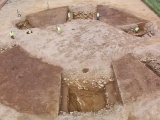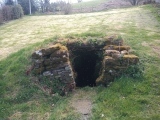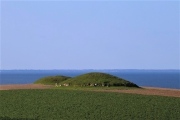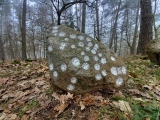Andy Burnham's Blog, page 173
April 30, 2021
Vaynor Farm Henge
Vaynor Farm henge in Carmarthenshire was uncovered in 2006 during the South Wales Gas Pipeline Project. It's located on a ridge overlooking the River Taf. Surviving as two banana-shaped rock-cut ditches with post or stone sockets along the interior, it's believed to be the most westerly henge yet discovered in Wales. Statistical modelling of a large number of radiocarbon dates indicated that it was built during the Late Neolithic, before 2600 BC. The monument may have been deliberately slighted, perhaps when the high ground was used for burial during the Bronze Age at which time the henge may have been an unwelcome reminder of earlier beliefs.
Published on April 30, 2021 06:26
April 28, 2021
Rhiwiau Well
The well is set on a steep, grassed hillside adjacent to Rhiwiau Farm House. It is a slightly dilapidated stone structure with ten steps down to a subterranean chamber that extends about 8' back into the hillside. Good, clear water lies at the bottom. Locally this well is known as the Roman Well, but it is uncertain whether it is Roman or Medieval and its Holy status is uncertain.
Published on April 28, 2021 07:00
April 25, 2021
Stones North East of Llyn Caerwych
Possible Standing Stones in Gwynedd. This is an enigmatic site. It is situated on a saddle between two low outcrops to the south west of Bryn Cader Faner, and just above the site known as Bryn Cader Faner Hut Circles. I first noticed a small tapering standing stone poking out of some marsh grass. The stone is 0.87m tall, 0.40m wide at the base and 0.18m deep. I then noted a large recumbent stone about 10m west, again poking out of some marsh grass. This stone had a flat side (facing east) and was tapered to a point. I began to clear the overgrowth only to discover another large stone sharing a pit with the flat faced stone.
Published on April 25, 2021 06:32
April 24, 2021
Cairn X1
0f those who visit the passage tombs at Loughcrew, Co. Meath, only a tiny minority turn aside to visit the three sites clustered together on Patrickstown, the wooded hill at the eastern end of the chain. Here lie the remains of an intriguing monument, site X1, the location of a stone (C1) decorated with a striking rayed design or sun motif. Watercolour illustration by G. V. du Noyer (1865) depicting the megalithic art on the north-west face of orthostat C1.
Published on April 24, 2021 04:27
April 23, 2021
Liselund Rundhøj 1
Liselund Rundhøj 1 is a well preserved round barrow measuring 20m wide by 4m tall. It was restored in 2013 along with two other round barrows near by. You can see one of these - Liselund Rundhøj 2 - in the background along with a wonderful sea view. There are kerb stones around the mound.
Published on April 23, 2021 15:57
April 21, 2021
Sperris Croft
Sperris Croft consists of seven hut circles strung out in a line along a ridge more than 700ft (214 m) above sea level, exposed and windswept. The huts measure between 20 and 46 ft (6.1 and 14m) in diameter.
Currently all seven houses are clear of bracken and gorse, thanks to the Penwith Landscape Partnership and Cornwall Ancient Monuments (CASPN) volunteers. Photo by Fof, who visited yesterday 20th April - looking across the small annex of one of the houses to the adjacent house.
Currently all seven houses are clear of bracken and gorse, thanks to the Penwith Landscape Partnership and Cornwall Ancient Monuments (CASPN) volunteers. Photo by Fof, who visited yesterday 20th April - looking across the small annex of one of the houses to the adjacent house.
Published on April 21, 2021 13:34
Castallack Round
Castallack Round is a good example of a late Iron Age or Roman period Round (farm settlement), despite it having been partly destroyed in the 19th-century. It has massive original walling on the east side and also a little on the west side. The entrance has huge upright stones and is found on the south-eastern side.
Published on April 21, 2021 13:14
Wollschow Grab (30)
The remains of the tomb Wollschow 30. The stone pictured has many large cup-marks. Part of a necropolis of around 40 tombs within 1 to 2km south of this location, close to the border with Poland.
Published on April 21, 2021 06:41
Greenhill North Ogham stone
An Ogham stone discovered in 1906 when the landowner 'was lowering a headland'. Around 40m north of, and in the next field to an existing Ogham stone - see our nearby sites list for this and many more sites in the area. This stone has been studied as part of the Ogham in 3D project, again see the links below.
Published on April 21, 2021 00:57
April 18, 2021
Lady Hill
A rather mysterious mound near Warrington. Is it a round barrow? It was excavated in 2007. Sheila Mughal writes: A few years back, myself and a group of folks interested in local history, plus Mark Olly (of Granada TV's Lost Treasures fame) and some archaeologists from Liverpool University, went to dig up Lady Hill at Golborne near Newton Le Willows. We did dig up a partially burned skull and it is our belief this is tumulus, but it has not as yet been recognised or marked on the map.
Published on April 18, 2021 09:21













